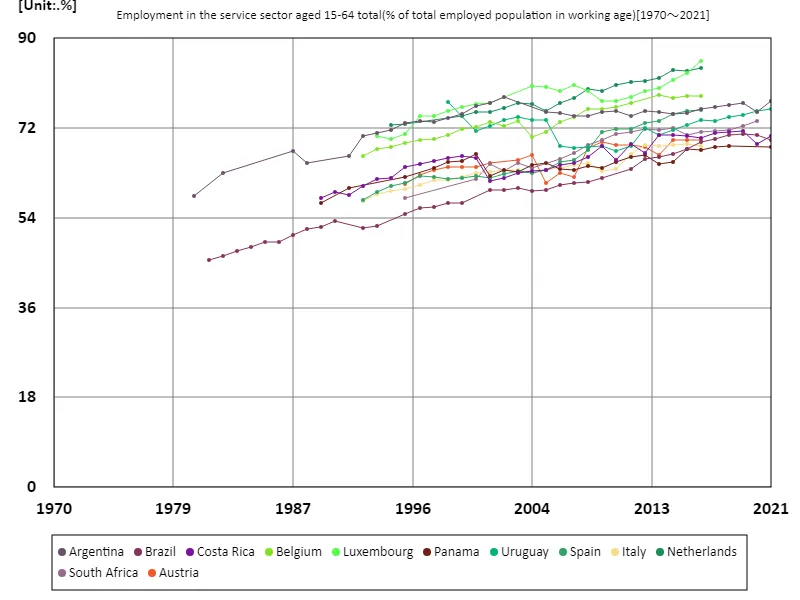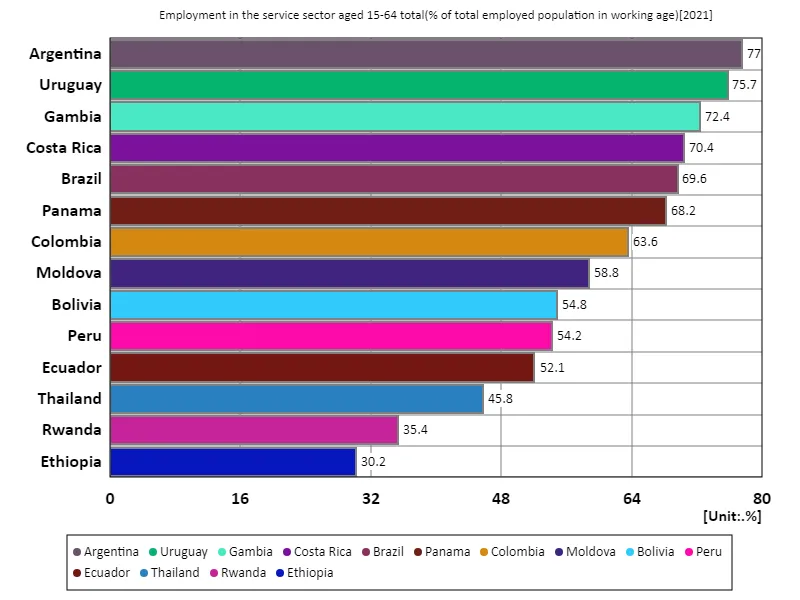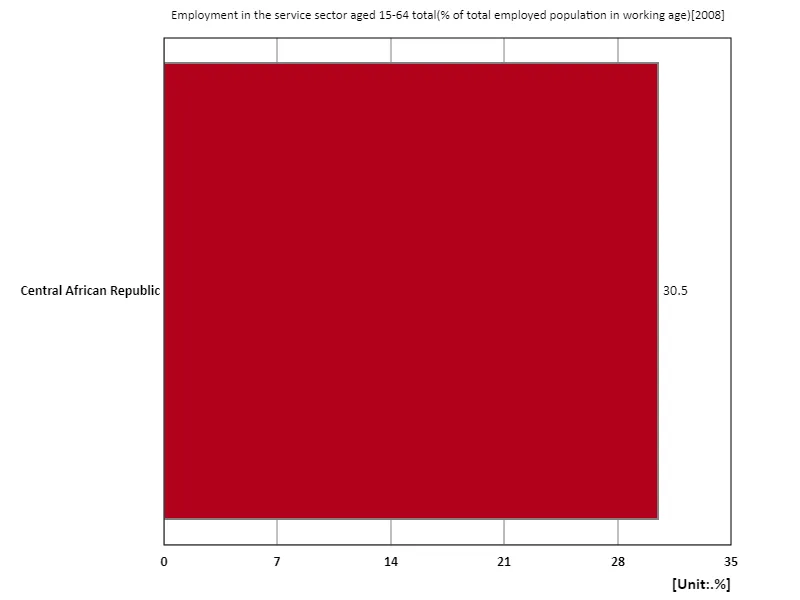- Abstract
- Employment rate for all 15-64 year olds in the service sector (percentage of working-age population)
- Employment rate in the service sector for all 15-64 year olds (percentage of working-age population) (worldwide)
- Employment rate in the service sector for all 15-64 year olds (percentage of working age working population) (Worldwide, latest year)
- Employment rate in the service sector for all 15-64 year olds (percentage of working-age population in the workforce) (region, latest year)
- Reference
Abstract
Argentina’s service sector employment rate for 15-64 year olds reached 77.5% in 2021, reflecting the country’s economic structure. For many years, Argentina has grown with the service industry as its main economic sector. This trend is more pronounced than in other Latin American countries, where the expansion of the service sector accounts for the majority of employment. In particular, commerce, education and healthcare are major sources of employment, which contribute to the high employment rate. In addition, Argentina’s high service sector employment rate is likely also influenced by the size of its domestic market and its progress in urbanization. This trend is indicative of economic maturity and industrial transformation, and is likely to continue in the future.
Employment rate for all 15-64 year olds in the service sector (percentage of working-age population)
Based on data from 1980 to 2021, trends in service sector employment reflect a maturing economy and structural changes. Luxembourg is particularly notable, having recorded a high service sector employment rate of 85.4% in 2016 and currently stands at 100%, the same level as its peak. This is the result of Luxembourg’s specialisation in high value-added areas such as financial services and professional services, and a shift in the focus of its economy towards the services sector. Since the 1980s, the service sector has expanded rapidly in developed countries, shifting away from manufacturing and agriculture. This has led to a general rise in employment rates in the service sector, which in many developed countries are in the 60% to 80% range. In particular, urbanization and digitalization have increased demand for the service sector and shifted the focus of employment. On the other hand, in developing countries, manufacturing and agriculture remain the main sources of employment, and employment rates in the service sector tend to be relatively low. Overall, it is clear that employment in the service sector increases as the economy develops and that in mature economies, the service sector becomes the main source of employment.


The maximum is the latest one, 85.4% of Luxembourg
Employment rate in the service sector for all 15-64 year olds (percentage of working-age population) (worldwide)
Looking at data from 1980 to 2021, the change in service sector employment rates shows the evolution of the economy. Luxembourg’s peak of 85.4% recorded in 2016 reflected the specialisation of its economy in financial and professional services. The current figure of 100% represents an extreme situation in which the entire working-age population is employed in the service sector. Overall, developed countries have seen a sharp rise in service employment rates, with notable increases from the 1980s to the 2020s. As urbanization, digitalization, and economic sophistication progress, the shift from manufacturing and agriculture to services has accelerated. In particular, sectors such as finance, healthcare, education and IT are growing and becoming the core of employment. Meanwhile, manufacturing and agriculture remain the main sources of employment in developing countries, with employment in the service sector remaining relatively low. Overall, as the economy matures, the service sector has come to dominate and account for the majority of employment.


The maximum is the latest one, 85.4% of Luxembourg
Employment rate in the service sector for all 15-64 year olds (percentage of working age working population) (Worldwide, latest year)
Based on 2021 data, the employment rate in the services sector for all 15-64 year olds averages 59.2%, with Argentina reaching a high 77.5%. Argentina’s high employment rate is the result of the country building its economy around services, with sectors such as commerce, healthcare and education being major sources of employment. Developed countries generally have a higher employment rate in the service sector, driven by economic maturity, urbanization, and digitalization. Since the 1980s, the service sector has grown rapidly and typically accounts for 70% to 80% of employment in many developed countries. In contrast, in developing countries, employment rates in the service sector tend to be relatively low, with manufacturing and agriculture being the main sources of employment. Additionally, the total figure of 829% is the result of aggregating data by number of countries and regions surveyed, which indicates large variations across countries. Overall, employment in the service sector has increased in line with the stage of economic development, indicating that the importance of the service industry increases as the economy becomes more advanced.


The maximum is 77.5% of Argentina, the average is 59.2%, and the total is 829%
Employment rate in the service sector for all 15-64 year olds (percentage of working-age population in the workforce) (region, latest year)
Based on 2008 data, the service sector employment rate for all 15-64 year olds was highest in the Central African Republic at 30.5%, with the overall average and total also at 30.5%. The data show relatively low levels of employment in the service sector, especially in developing countries. The service sector employment rate of 30.5% reflects the fact that in low- and middle-income countries such as the Central African Republic, major parts of the economy depend on agriculture and manufacturing. In these countries, service sector employment remains low because the services sector is relatively underdeveloped and most of the economy is concentrated in productive activities. On the other hand, the figures are very different in developed countries, where employment rates in the service sector tend to be higher. In developed countries, as economies mature and urbanize, service sectors such as commerce, healthcare, education and IT are becoming major sources of employment. The 2008 data show the characteristics of economic structures and labor markets in developing countries that suggest that these countries will need to increase the importance of the service sector as their economies develop.


The maximum is 30.5% of Central African Republic, the average is 30.5%, and the total is 30.5%



Comments